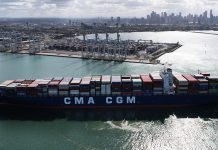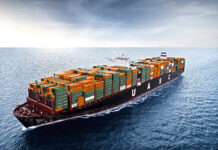
Combining route splitting with advanced weather routeing can create commercial and operational opportunities, writes Christoph Rasewsky, Global Container Sector Lead of ABS
Container shipping operations require a unique combination of conditions to operate at maximum efficiency, safety and sustainability. These conditions are rarely found together or in the correct sequence, but each must be addressed if container vessels are to achieve compliance and remain safe and competitive.
From a safety point of view, ships must avoid sea conditions that can lead to high roll angles, reducing the risk of container losses by adhering to lashing force limits.
Cargo loading must be optimised according to the area of operations and seasonal conditions in order to maximize vessel utilization and require fewer time-consuming re-stows.
Vessel operators are also under pressure to improve efficiency per loaded container, both to lower the slot cost, reduce associated carbon emissions and offset rising transport costs from new environmental regulations.
In embarking on the development of the new CLP-V(PARR) class notation, ABS focused on how to combine these key objectives to help ship owners navigate current challenges and prepare for the future.
Enhancing Safety
Container losses at sea are a major concern for the industry, and so the first goal was to find a solution that not only reduces this risk but could even eliminate them altogether.
Recognizing that parametric and synchronous rolling is the primary cause of container losses, ABS sought ways to prevent critical situations involving high roll angles during ship operations. This phenomenon is well-understood, and the susceptibility of ships to roll in specific wave patterns can be simulated.
Working together with specialist weather routeing provider StormGeo, we developed a digitalized application that integrates this information into the ship’s daily operations via StormGeo’s s-Planner voyage planning software. The solution involves extended weather routeing that accounts for a ship’s specific sensitivity to parametric and synchronous rolling, providing the crew with guidance on avoiding high roll angles.
By adjusting the ship’s course or modifying its speed as needed, they are able to manage roll angles effectively, thereby preventing excessive lashing forces and eliminating the risk of container loss.
Creating Efficiency
The next challenge was on improving the efficiency of container ship operations.
Mainlane container routes traverse different time zones and various sea areas, in which conditions vary seasonally. This variability means that ships must be prepared for heavy sea conditions in some regions while they will experience milder conditions in others.
Traditionally, this has led to sub-optimal cargo loading, with ships under-loaded in order to withstand potentially heavy seas, with the result that capacity is not fully utilized in calmer waters.
Inefficiencies also arise due to long port lay times and thus higher port fees, as well as non-optimized speeds between ports.
The CLP-V(PARR) notation addresses this issue through route splitting, allowing cargo loading to be optimized for specific segments of the route rather than the entire journey. This improvement not only optimizes cargo capacity but also reduces costly and time-consuming re-stows.
The result is optimized speeds between ports and time savings at berths resulting in lower port fees and enhanced performance.
Delivering Sustainability
Managing slot costs remains a critical Key Performance Indicator for liner operators. Enabling them to achieve lower costs per loaded container creates a direct benefit to their customers. They must also respond to upcoming emission regulations that will significantly impact cargo transport costs.
The higher cost of green fuels as well as the cost of CO2 allowances and penalties will both add to transport costs. The CLP-V(PARR) notation can be used to help operators improve payload and bring down slot costs, helping to offset these cost increases.
For example, using the notation, a modern 16,000 TEU container vessel can carry an additional tier of loaded containers on deck between Singapore and Tangier on the traditional Asia-Europe route. This means a total of 320 additional 40ft loaded containers thanks to a 4.4% increase in optimized on-deck stowage capabilities.
This creates an overall benefit to the supply chain and a substantial reduction in cargo transport costs.
By addressing both current operational and near-term regulatory challenges, the CLP-V(PARR) notation establishes a unique solution set for container lines. In the process, it underscores ABS’s reputation for safety and as an innovative partner for container liner operators.
Author of the Article: Christoph Rasewsky, Global Container Sector Lead of ABS

Christoph Rasewsky heads the global container sector of ABS. He looks back on 15 years of experience in container shipping and an excellent reputation in consulting for ultra-large container ships.
He also holds a diploma degree in naval architecture, a master’s degree in business administration and a certificate in ship finance and management.





